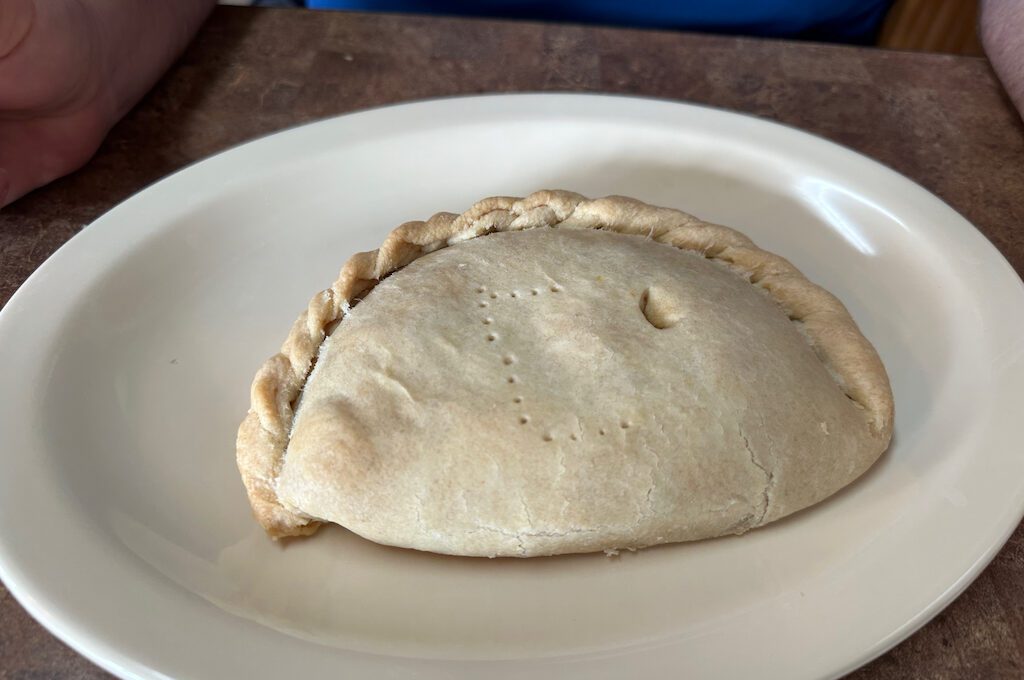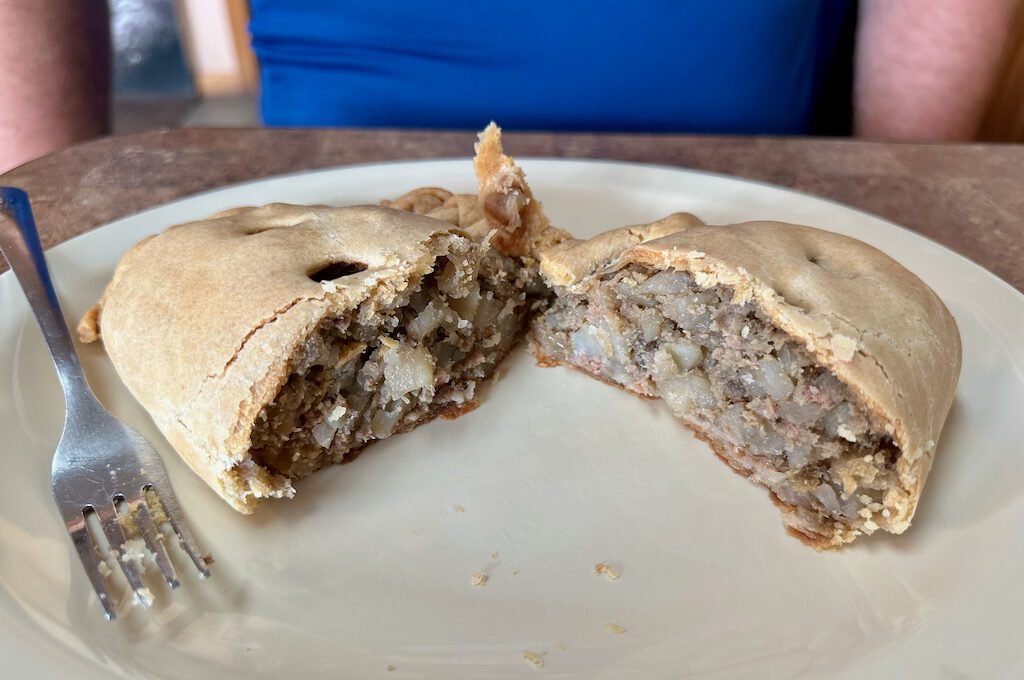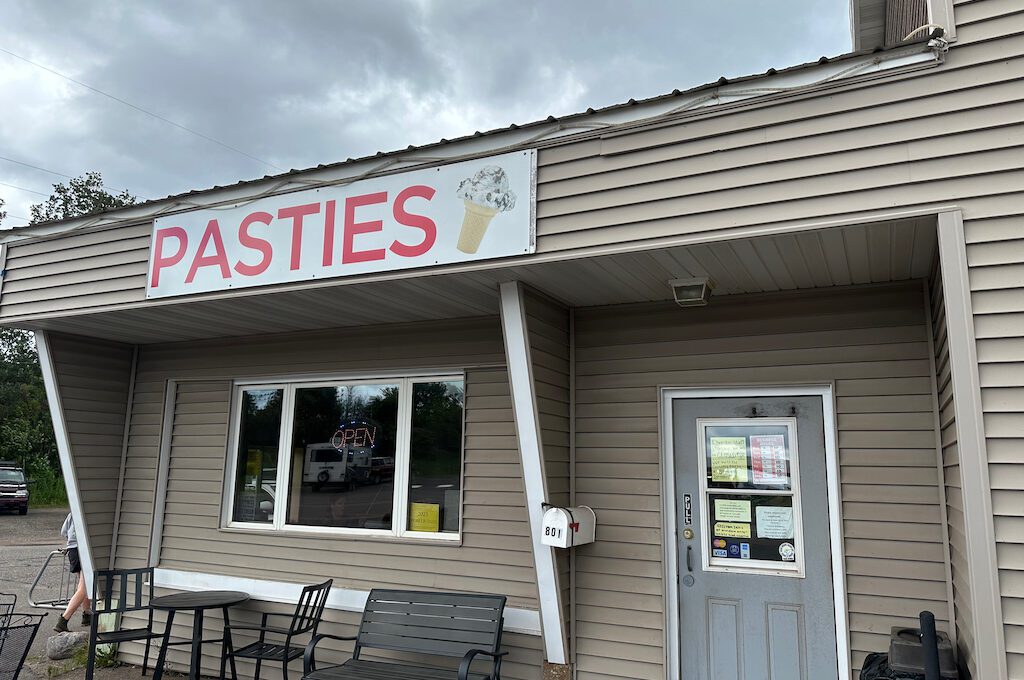One of my favorite aspects of traveling is discovering local delicacies, especially whenever they have a rich history to go along with (hopefully) rich flavors. Savoring a good local dish is akin to grasping the essence of a place, creating an intricate bond between palates and landscapes that you’re sure to remember.
No visit to to the Upper Peninsula of Michigan would be complete without trying a pasty which has become almost a culinary rite of passage for tourists that come through this far northern region of the country. And in this article, I’ll dive into this flaky dish, giving you some history and tips on choosing where to feast on your first pasty.
The history of the pasty
The pasty, a savory pastry filled with a mixture of meats, vegetables, and seasonings, has been around for probably over 800 years. The exact origin of the dish is still somewhat of a mystery but there are a plethora of mentions of it throughout history.
The word “pasty,” which yes, unfortunately rhymes with “nasty,” derives from the Medieval French word for a pie filled with meat, vegetables or cheese, and baked without a dish.
You can find a mention of it in cook books dating back to around 1300. And they have been a part of major literary legacies ranging from The Canterbury Tales to a few of Shakespeare’s works.
Wife, bid these gentlemen welcome. Come, we have a hot venison pasty to dinner: come, gentlemen, I hope we shall drink down all unkindness.
The Merry Wives of Windsor Act 1 Scene 1
Pasties even passed royal taste tests, as a letter from a baker to Henry VIII’s third wife Jane Seymour states: “hope this pasty reaches you in better condition than the last one.”
But it was during the 17th and 18th centuries, that the pasty became popular with working people in England’s southwest region (Cornwall and Devon) and this is when its more modern form took shape consisting of beef, potatoes, swedes (rutabagas) and onions.
Embraced by families, fishermen, and farmers alike, the pasty’s true champions were the tin miners, drawn to its ingenious shape that allowed convenient portability and utensil-free consumption. On top of that, its folded pastry retained warmth for hours, and even when chilled, a simple warming over a candle-lit shovel revitalized its comfort.
In the mid-19th century, the Upper Peninsula of Michigan welcomed the introduction of pasties as Cornish miners, in pursuit of work in the iron and copper mines, brought this tradition to these northern forests.
Just like its stint in England, the pasty proved its worth as a handy and transportable feast, perfectly tailored for the strenuous work below the surface.
Its popularity didn’t just stop with the Cornish; other immigrant groups like the Finnish and Italians, who eventually formed a bigger crew, hopped on the pasty train too. They didn’t hold back either, giving the classic recipe their own remix – like swapping turnips for carrots.

As time passed, the pasty’s allure transcended the confines of mining communities, transforming into a cherished regional delicacy within the Upper Peninsula.
Its distinction elevated it to the status of a local specialty, captivating not only locals but also drawing visitors from afar, making it a prominent tourist attraction.
Today, the Cornish pasty has been awarded Protected Geographical Indication (PGI) by the European Commission, so it enjoys the type of esteemed status as revered entities such as champagne.
A Cornish pasty, as defined by its PGI status, should:
- Be shaped like a ‘D’ with crimps on one side.
- Have beef, swede, potato, and onion as its main ingredients, seasoned lightly with salt and pepper, while keeping a chunky texture.
- Be golden and keep its shape after cooking and cooling.
And most importantly, a Cornish pasty must be made in Cornwall to receive the authentication stamp.

Where to find a pasty Upper Peninsula
It’s not hard to find a good pasty in the Upper Peninsula. We’ve eaten good pasties at Lawry’s Pasty Shop and Iron Town Pasties in and near Marquette, MI, but you can find them all over and in quite a few different forms.
The traditional pasty in the Upper Peninsula is a beef pasty loaded with beef, potato, rutabaga, and onion.
Some places serve up mini pasties which you can order by the dozen and sometimes you can find them in different sizes such as a 12 ounces or 17 ounces.
Beyond the traditional pasty they have breakfast pasties with ham, potato, egg and cheese along with vegetarian and gluten-free versions. Sometimes, the world of pasties stretches its boundaries to include more daring versions, like spicy jalapeño-infused varieties that break away from the idea of plainness often associated with traditional English food.
People often enjoy pasties with various sauces, offering a wide range of choices. Gravy is a common option, but others might prefer ketchup, mustard, butter, or something else entirely. The decision is entirely up to you and your taste preferences but you may want to ask what options you have before ordering.
As for how these things taste….
A pasty tastes like a hearty and flavorful combination of tender meats, vegetables, and seasonings encased in a golden, flaky pastry shell. They always remind me of a type of chicken pot pie but with the noticeable hint of rutabaga which brings a flavor that could be described as a cross between a turnip and a cabbage.
Not every person is a “pasty person” so you should be prepared for the possibility of not liking the pasty or at least not being in love with it.
So I suggest that you go out and work up a good appetite and then go for your first pasty because then you’ll appreciate it a lot more.
My personal tip: Ketchup mixed with a little Tabasco goes a long way to bring out some flavor!

Final word
Participating in the nearly millennium-old tradition of savoring a pasty holds its own charm, even if the experience of relishing it within the cozy confines of a restaurant vastly contrasts with the historical context of eating it amidst the dark chambers of a mine. If you come to the UP, you have to give them a shot.
Daniel Gillaspia is the Founder of UponArriving.com and the credit card app, WalletFlo. He is a former attorney turned travel expert covering destinations along with TSA, airline, and hotel policies. Since 2014, his content has been featured in publications such as National Geographic, Smithsonian Magazine, and CNBC. Read my bio.


